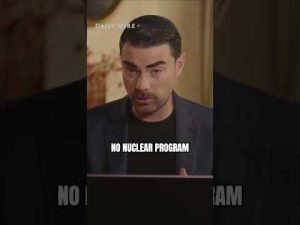In a world filled with uncertainty and tensions that seem to rise faster than a game of Whack-a-Mole, the news of a ceasefire between Israel and Iran may just bring a glimmer of hope to a region fraught with conflict. Recent discussions have shed light on the ongoing threats posed by Iran, particularly its ambitions regarding nuclear weapons and ballistic missile proliferation. The Israeli Ambassador to the United States, Yechiel Leiter, has highlighted the strategic goals that remain firmly planted in Israel’s vision for a secure future. The primary objective is crystal clear: eliminate any potential threat from Iran that could jeopardize the existence of Israel.
This strategic vision has evolved over the years, adapting to the precarious nature of Middle Eastern geopolitics. Essentially, there are three prongs to this threat: Iran’s pursuit of a nuclear weapon, its burgeoning ballistic missile program, and the alarming support it provides to proxy groups such as Hamas, Hezbollah, and the Houthis. These proxies have created a volatile ring around Israel, designed to strike simultaneously, complicating any defensive response. Despite recent claims of weakness from Iran, their attempts to leverage regional tensions and fund conflict through proxies are strategies that still require vigilance.
While it might seem that Iran is floundering with their recent military responses described as less than devastating, it is essential to recognize the long history of their strategic maneuvers. The situation on the ground can change with a rapidity akin to a rollercoaster ride. However, amid these twists and turns, Israel asserts that it has made significant strides. In the recent past, Israel has reportedly diminished the capabilities of Hamas and Hezbollah while even causing some shifts in the leadership of Lebanon and Syria. This progress has allowed for a glint of optimism regarding the broader concept of the Abraham Accords by fostering connections and dialogue between Israel and other Arab states, including a tantalizing possibility of Saudi Arabia joining in.
However, not all reactions have been encouraging. After a series of military operations designed to limit Iranian influence, the situation did a waltz when Saudi Arabia began to voice discontent with Israel’s strikes against Iran. This sudden shift seems baffling since Saudi Arabia and Iran have long been at odds. It’s a curious conundrum: one can almost hear the collective scratching of heads from global policy analysts trying to decipher this new narrative. It would be wise to remember that politics often resembles a chess game where players must position themselves carefully to avoid checkmate.
But here’s the kicker—while discussions of a ceasefire have emerged, the underlying tension has not dissipated. Iran’s capability and desire to challenge the status quo still linger. Even with a temporary halt in hostilities, it’s important to remain vigilant. The rhetoric surrounding such agreements could be akin to a magician’s illusion—appealing to the eye but often hiding the more complex realities beneath. The hope remains that this moment could serve as a springboard for positive change in Iran, empowering the voices of freedom that have long been suppressed.
Ultimately, this latest chapter of Middle Eastern politics reveals both the strength and fragility of alliances and hostilities. As observers, we must stay engaged and informed, ensuring our leaders understand that the game of strategy is ongoing and requires careful maneuvering. If the situation leads to lasting peace and security, it would not only benefit Israel but also potentially create a platform for progress across the region. Until then, many will hold their breath and keep a wary eye on developments from the complex chessboard of international relations.







